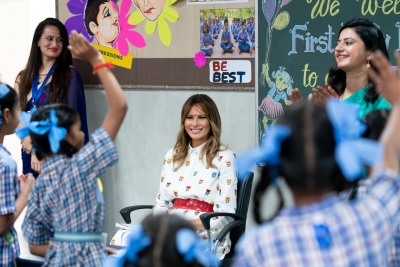When was Happy Curriculum launched in India?

On July 2, 2018, the Delhi Government launched the ‘Happiness Curriculum’ for students from nursery to class VIII in schools run by it, in an effort to shift the focus from students’ academic achievement to their emotional well-being. The best part of the ‘Happiness Curriculum’ is that there is no homework, no exam or no marks.
In the last two years, the system has garnered attention with representatives from other Indian states and countries visiting the schools. After the U.S, First Lady Melania Trump attended one of the sessions of the ‘Happiness Curriculum’ during her recent visit to India, there has been a renewed interest in the programme.
Whose initiative is the Happiness Curriculum?
The ‘Happiness Curriculum’ is a flagship programme of the Arvind Kejriwal-led AAP government in Delhi. It was envisioned by the Education Minister of Delhi, Manish Sisodia. The content of the programme was designed by a committee of members including Delhi government teachers, lecturers from the District Institute of Education and Training (DIET) and principals, and organisations working in the area of child psychology.
What is Happiness Curriculum?
Instead of focussing only on the IQ (intelligent quotient), the Happiness Class focusses on students’ EQ (emotional quotient) and SQ (social intelligence quotient) as well. The curriculum incorporates meditation, mental exercises and storytelling in teaching for a holistic development of the students.
Manish Sisodia, in his book Siksha, lists the three main aspects of the curriculum: mindfulness meditation, inspirational stories to make children responsible and mature and activity-oriented discussions where children are encouraged to introspect and react.
How are the classes conducted?
The ‘Happiness Class’ takes place in all schools run by the Delhi government during the first period of the day, from Monday to Saturday. It breaks away from traditional teaching methodology and involves a combination of meditation, value education, and creative activities which prompt a student to think. On Mondays, mindfulness exercises are done, while on Tuesdays and Wednesdays, students are told stories which are followed by discussions. Students participate in creative activities on Thursdays and Fridays. And Saturdays are reserved for self-expression, when the students speak their mind and reflect on their behavioural changes.
The programme groups children into three categories: kindergarten to grade two, grades three to five, and grades six to eight. The curriculum has been designed catering to each group.
What is the aim of the programme?
According to the Delhi Government, the objectives of the ‘Happiness Curriculum’ are to enable children to develop self-awareness and mindfulness, critical thinking and communication skills. The Curriculum also teaches them to express themselves freely and creatively, to develop empathy, and to ensure healthy relationships with family, peers and teachers. Besides, it aims at helping learners to apply life skills to deal with stressful situations.
Kejriwal termed the ‘Happiness Curriculum’ as the third stage of reforms in the education sector initiated by his government after focussing on infrastructure development and motivation of teachers in the government schools.
Why did Melania Trump show interest in the ‘Happiness Curriculum’?
The Happiness Curriculum is similar to the Be Best programme initiated by her in the U.S. to teach children and young adults to not bully others, avoid drugs and take care of themselves.
Picture Credit : Google